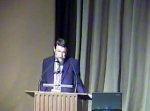VIDEOCAST - Henry Maguire “Nectar and Illusion: Art, Nature, and Rhetoric in Byzantium.”

Henry Maguire delivered the 31st Annual Walton Lecture in honor of Gennadius Librarian Francis R. Walton (1961-1976), on May 8.
The lecture, entitled “Nectar and Illusion: Art, Nature, and Rhetoric in Byzantium” was based on the premise that Byzantine writers treated rhetoric with ambivalence. Some authors expressed admiration for those who used rhetoric to bring elegance to their speech, while others viewed the techniques of rhetoric as agents of deceit and trickery. The ambivalence felt by the Byzantines concerning rhetoric was also felt about the delights of terrestrial nature, which, on the one hand, were a source of pleasure, and on the other, corruptible and fleeting compared to the spiritual rewards of heaven. Both in their literature and in their art, Byzantines of the Middle Ages found ways to put nature securely in its subordinate position, even while they were still prepared to deploy their visual and verbal eloquence in acknowledgement of its charms. The talk is part of Maguire’s forthcoming book Nectar and Illusion: Nature in Byzantine Art and Literature (Oxford University Press, Onassis Series in Hellenic Culture).
Henry P. Maguire is Professor Emeritus in the History of Art Department of Johns Hopkins University, where he taught from 2000 to 2010. Prior to Johns Hopkins University he taught at the University of Illinois, Urbana-Champaign (1979 – 2000), and held a joint appointment at Dumbarton Oaks and the Harvard University (1973-1979). From 1991-1996 her served as Director of Byzantine Studies at Dumbarton Oaks.
He is the author of Art and Eloquence in Byzantium (Princeton University Press, 1981; paperback reprint, 1994); Earth and Ocean: The Terrestrial World in Early Byzantine Art (University Park, 1987); “The Icons of their Bodies”: Saints and their Images in Byzantium (Princeton University Press, 1996); and co-author with Eunice Dauterman Maguire of Other Icons: Byzantine Secular Culture and the Power of Art (Princeton University Press, 2006); and with Ann Terry, Dynamic Splendor: the Wall Mosaics in the Cathedral of Eufrasius at Porec (Penn State University Press, 2007).
His articles have been reprinted in: Rhetoric, Nature and Magic in Byzantine Art (Variorum Press, Aldershot, 1998); and Image and Imagination in Byzantine Art (Ashgate/Variorum, Aldershot, 2007). He has also published the exhibition catalogs Art and Holy Powers in the Early Christian House ((with Eunice Dauterman Maguire and Maggie Duncan-Flowers), University of Illinois Press, Urbana, 1989); and Ceramic Art from Byzantine Serres ((with Eunice Dauterman Maguire and Demetra Papanikola-Bakirtzis), University of Illinois Press, Urbana, 1992). He has also edited numerous books and journals.
His current research concerns Byzantine art and nature, Byzantine court culture, Byzantine art and Venice.
If you have trouble viewing this videocast, make sure your browser has Flash installed: Download Flash Player
This year the Gennadius Library would like to thank Lloyd E. Cotsen and Margit Cotsen for their generous support.